
Some recipes recommend trimming off okra’s stem ends, others suggest peeling off tough skin from the conical caps only, and others suggest slicing the pods crosswise. It is all a matter of preference.
Ladies Fingers
Okra, Hibiscus Esculantus, sometimes called “ladies fingers,” is a staple vegetable of the American South. The plant can grow up to eight feet tall and blooms with yellow, 2-inch flowers that resemble hibiscus, and just like the hibiscus, the flowers remain open only for one day. Okra can be bright green or burgundy, and the long, tender seedpod resembles Cuban cigars and is in the same plant family as cotton. When cooked properly, okra has a delicate, moist, and vegetal flavor. Okra is very versatile and is delicious fried, boiled, baked, broiled, pickled, or stewed. It is used for its thickening qualities in Cajun dishes, like Creole seafood gumbos, red beans and rice, and étouffées.
History
Okra originated around the equator in Africa, in the current regions of Congo, Angola, Ethiopia, and Sudan. It was brought to the Americas by enslaved peoples, where it was quickly adopted. They brought with them the seeds of their homeland foods, which, according to legend, were hidden in their hair. It is believed that Native Americans taught them how to cultivate the seeds and cook them in a new way with local corn, sweet potatoes, and bean varieties. In modern times, okra has been associated with the cooking of the American South, even called “the most southern vegetable,” but it also remains an important ingredient in the cuisines of Africa, Asia, and Latin America.
Purchasing
Okra is available at local stores and farmers’ markets all summer and into fall and in the winter at Asian grocery stores. Look for okra not bigger than 3 inches in length. Larger pods tend to be tough; be sure to cut off woody stems before cooking.
Cooking
Cooked okra can tend to have a slimy texture because it contains a pectin-like substance called mucilage, which is also present in seaweed, cacti, and flaxseeds. The viscous liquid inside the pod resembles the aloe vera plant. This gelatinous substance has thickening qualities and is used in many classical Cajon and Creole dishes. However, the interior mucilage can be reduced by high-heat cooking methods or by adding salt that draws the viscous liquid from pods. Salting okra before cooking and letting it stand for 1 hour, then rinsing and drying it before cooking, can also help to eliminate the slimy texture. Mucilage, also called roping, is a type of soluble digestive fiber that aids in germination and prevents the plant’s seeds from drying out. (Nature is smart!)
Growing and Storing
Okra is easy to grow. It tolerates poor soil and loves Midwest summer heat, so it grows fast. Okra pods must be picked within 4-5 days of blooming, when about the size of your index finger, while still tender. Okra can also be frozen for winter consumption, but it does not hold up well after harvesting. Be sure to store it in a paper bag in the refrigerator and eat it within a few days. Blanching is recommended to protect the flavor and prevent the loss of vitamins.
Health and Science
Okra is gaining in popularity among cooks and food scientists because it is a very healthy vegetable and a potent antioxidant, containing a wide variety of minerals, vitamins A, C, B6, and K, the “clotting vitamin,” and also helps maintain strong bones. Ongoing research suggests that okra provides benefits for goiter sufferers and blood sugar control. It is also high in fiber.
Southern-Style Fried Okra
Magda Born
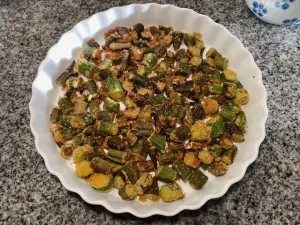
INGREDIENTS
- ½ lb okra
- ½ c oil
- 1 Tbsp butter optional
- ¼ c buttermilk optional
- ½ c flour
- 1 c medium grind cornmeal or polenta
- Salt and pepper to taste
INSTRUCTIONS
1. Gather your ingredients
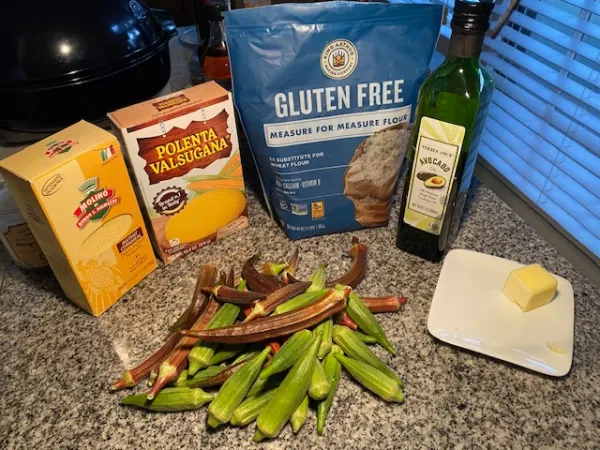
2. Remove the stems and cut okra into small, even pieces.

3. If not using buttermilk, rinse okra quickly in cold water so that the breading sticks.

4. Combine flour and cornmeal in a bowl.
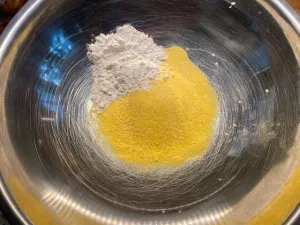
5. Combine okra with the flour mixture and toss to coat.
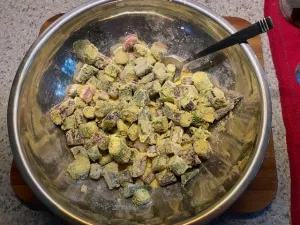
6. In a cast-iron skillet, heat the oil on high and add okra. Cooking okra quickly at high heat prevents the dreaded slimy texture. Cook until brown and crisp, about 3-5 minutes. Using a slotted spoon, transfer to a prepared plate. Season with salt and pepper while still hot. Serve immediately.

7. To freeze okra, spread it on a baking sheet so the individual pieces do not stick together.
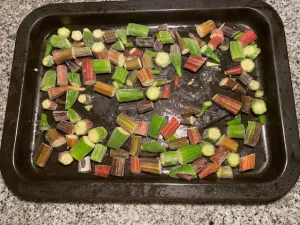
8. As always, share food with friends!
Magda Born
mborn@kckpl.org
Community Services Librarian
Kansas City, Kansas Public Library
625 Minnesota Ave.
Kansas City, KS 66101
913-295-8250 ext 1103
Resources:

Okra: a savor the South cookbook by Virginia Willis
Format: Book
Call Number: 641.6564 WILLIS
Publication Date: 2014

Simply West African / Easy, Joyful Recipes for Every Kitchen: a Cookbook by Pierre Thiam
Format: Book
Call Number: XX(1192115.1)
Publication Date: 2023

The blue zones American kitchen: 100 recipes to live to 100 by Dan Buettner
Format: Book
Call Number: 641.563 BUETTNER
Publication Date: 2022

Vegetables illustrated: an inspiring guide with 700+ kitchen-tested recipes by America’s Test Kitchen
Format: Book
Call Number: 641.65 AMERICA
Publication Date: 2019

Food from across Africa by Duval Timothy, Jacob Fodio Todd, Folayemi Brown, Toby Glanville, Sophie Davidson
Format: Book
Call Number: 641.596 TIMOTHY
Publication Date: 2016

Gumbo by Dale Curry
Format: Book
Call Number: 641.813 CURRY
Publication Date: 2015